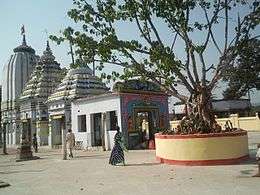Athmallik State
Athmallik State was one of the princely states of India during the period of the British Raj. The state was a former jagir recognized as a state in 1874[1] and had its capital in Kaintaragarh (Kaintragarh, Kaintira[2] or Kaintura).[3] Its last ruler signed the accession to the Indian Union in 1948.
| Athmallik State ଆଠମଲ୍ଲିକ | |||||||
|---|---|---|---|---|---|---|---|
| Princely State of British India | |||||||
| 1874–1948 | |||||||
.jpg) Athmallik State in the Imperial Gazetteer of India | |||||||
| History | |||||||
• Established | 1874 | ||||||
• Accession to the Union of India | 1948 | ||||||
| |||||||

The emblem of the state was the Kadamba flower.[3]
History
The origin of Athmallik State is obscure. Most of the state was covered by densely forested hills.[2] In the 11th century a jagir was established by King Prattap Deo of the Kadamba Dynasty. Prattap Deo was said to have found a Honda metal vessel which was considered an auspicious sign, after which the territory was then named as "Hondpa". In later times one of the chiefs divided the state into eight divisions and placed one subchief called "Malla" in each division in order to suppress the unruly tribes after which the kingdom changed its name from "Hondpa" to "Athmallik".[4]
During the British Raj Athmallik was one among the 26 Feudatory States of Orissa.[5] The state was mentioned as a tributary of Baudh State in 1904. In 1874 the Zamindari, locally styled as Samant was recognized as Raja and in 1894 a sanad was granted by the British recognizing Athmallik as a state in its own right.[3] Kaintaragarh was the capital of Athmallik State. The state's accession to the Indian Union was signed in Dhenkanal during the rule of Kishore Chandra Deo in 1948. It remained under Dhenkanal District till 31 March 1993 and, owing to the bifurcation of the district, Athmallik Sub-Division is now part of Angul District in Odisha.
Rulers of Athmallik
The Rajas of the princely state were:[6]
- 1874 – 4 Feb 1877 Jogendra Samant (b. 1821 – d. 1877)
- 4 Feb 1877 – 1902 Mahendra Deo Samant (b. c.1848 – d. 1902) (personal style Maharaja from 1890)
- 1902 – 3 Nov 1918 Bibhendra Deo Samant (d. 1918)
- 3 Nov 1918 – 15 Aug 1947 Kishor Chandra Deo Samant (b. 1904 – d. c.1971)
- 3 Nov 1918 – 24 Dec 1925 L.E.B. Cobden-Ramsay -Regent
See also
References
- Princely States of India A-J
- Imperial Gazetteer of India, v. 6, p. 122.
- L. E. B. Cobden-Ramsay, Feudatory States of Orissa: Bengal District Gazetteers, p.115
- Our Athmallik
- L. E. B. Cobden-Ramsay, Feudatory States of Orissa
- "Rulers". Rulers.org. Retrieved 26 October 2012.